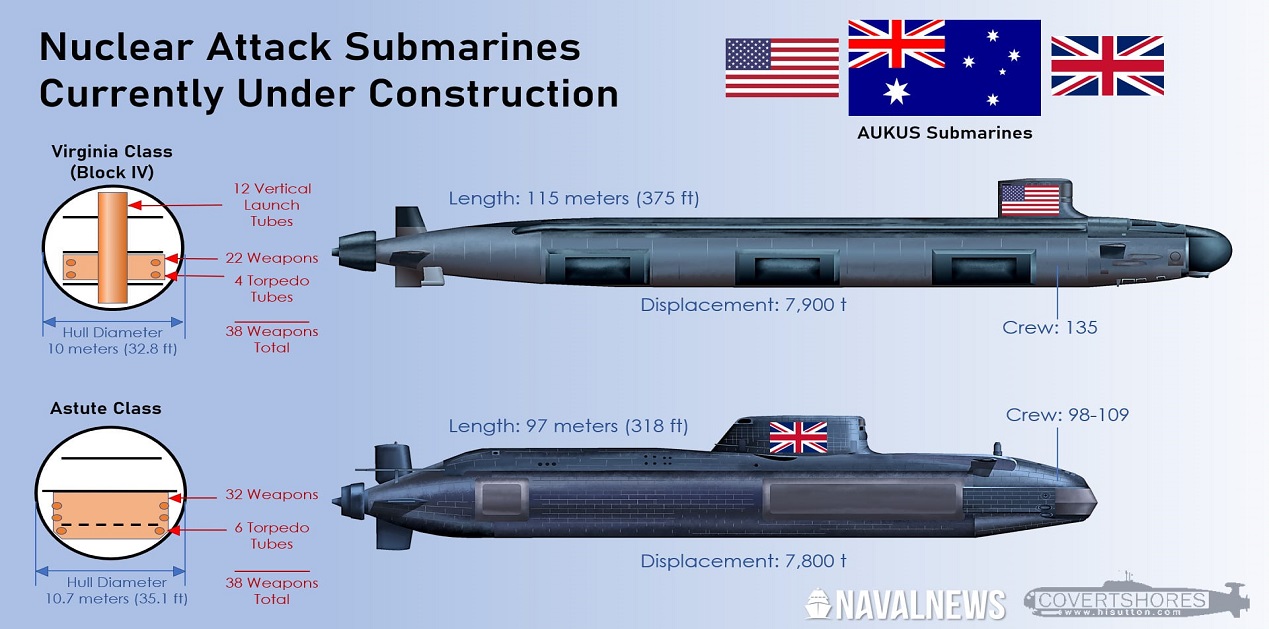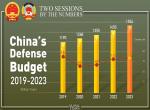Two strategic groupings – the Quad and AUKUS – are in the news that has caught world’s attention. While the Quad has been for been in existence for some time now, AUKUS is a recent construct. When in September 2021, Australia, the UK and the US announced AUKUS, a new security partnership with the objective to promote a free and open Indo-Pacific that is secure and stable there were murmurs in certain quarters in Japan and India that as two members of the Quad grouping, neither were consulted before its announcement. As it transpired subsequently, this historic trilateral decision was just to compliment the agenda of the Quad.
The first major initiative of AUKUS was the decision taken on 14 March 2023 to support Australia in acquiring conventionally-armed, nuclear-powered submarines (SSNs), enabling Australia to achieve this critical capability. The joint statement of the leaders of the three AUKUS countries contained the decision to deliver SSN-AUKUS, a trilaterally-developed submarine based on the UK’s next-generation design that incorporates technology from all three nations, including cutting edge US submarine technologies. The statement also observed that while both Australia and the US shall operate SSN-AUKUS as their submarine of the future, Australia and the UK shall begin work to build the submarines in their domestic shipyard by 2030.
A planned structured approach was announced so that the delivery could be made based on mutual commitments from the three nations at the earliest possible date.[1] It was agreed that work to build the submarines must begin in earnest and the military and civilian personnel of the three nations shall visit the submarine bases to accelerate training. This includes the US to increase SSN port visits to Australia beginning in 2023, Australian sailors joining for training and development and the UK increasing visits to Australia beginning in 2026.[2] Starting in the early 2030s, the US intends to sell Australia three Virginia class submarines, with the potential to sell up to two more if needed. While the UK shall deliver its first SSN-AUKUS to the Royal Navy, Australia will deliver the first SSN-AUKUS built in Australia to the Royal Australian Navy in the early 2040s. The entire plan is designed to support Australia’s development of the infrastructure, technical capabilities, industry and human capital necessary to produce, maintain, operate and steward a sovereign fleet of conventionally-armed, nuclear-powered submarines.
When the AUKUS partnership was formed in September 2021, the three nations made a commitment to maintain highest nuclear non-proliferation standards. The decision taken on 14 March was based on that commitment. The plan leverages the three member nations’ industrial capacity to produce and sustain interoperable nuclear-powered submarines for decades to come, besides expanding individual nation’s and collective undersea presence in the Indo-Pacific. The objective is to contribute global security and stability.
The decision for Australia’s acquisition of nuclear-powered submarines is the single biggest investment in Australia’s defence capability and represents a transformational moment in its defence and economy. The decision of the AUKUS on this was in response to unprecedented strategic challenges in the recent times. This shall also see record investment in defence, skills, jobs and infrastructure.[3] It shall also provide significant, long-term strategic benefits for all three countries.
Australia expects that the phased approach will see an investment of $6 billion in building industrial capability and workforce over the next four years. It would also create around 20,000 direct jobs over the next 30 years. Once the SSNs are built, Australia can take pride that those would be Australia’s sovereign capability, commanded by the Royal Australian Navy and sustained by Australians in Australian shipyards. Australia hopes that its proud record of leadership in the international nuclear non-proliferation regime would have got additional heft. The enhanced defence capability of the three partner nations shall contribute to the maintenance of strategic balance in the Indo-Pacific.
There is historical precedent to the submarine building project. Critics view this alliance between the Anglophone group to build, man and arm each other’s nuclear subs in Asia is seriously ambitious with plenty of unpredictability in the future. In 1908, the second USS Missouri, an American battle, sailed from San Francisco to Sydney, part of the so-called Great White Fleet’s tour of Asia. Her successor, the third USS Missouri, hosted Japan’s surrender in 1945. So, now on 13 March 2023, the fourth USS Virginia, a Virginia-class attack submarine made its presence, thereby signalling the US naval power in the Pacific. Thus the submarine agreement will intensify involvement of the US and the UK in the Pacific and bind the three allies together in unprecedented ways, into the 2040s and beyond.
Response from Beijing
When the AUKUS security pact was inked 18 months back, it angered Beijing. This time too, as expected Beijing expressed resentment as the new agreement allows sharing the technology for building nuclear-powered submarine, which the allies justify shall help ease tensions throughout the Pacific. The truism, however, is that China’s growing regional footprint is a matter of concern to the countries in the Indo-Pacific. China has repeatedly accused the alliance of weakening nuclear non-proliferation objectives.
The US denies that the alliance was formed with the aim to contain China. On the other hand, the US accuses Beijing for prompting an increasingly resolute response from its allies in the Indo-Pacific with its provocations in the South China Sea and around Taiwan, military exercises with Russia, border clashes with India and economic warfare with Australia. Therefore, the three AUKUS partners entered into the submarine agreement as it is intended to integrate trilateral submarine operations, greatly extending the range of Australia’s underwater fleet and allowing coordinated patrols far closer to the Asian mainland without a port call. The presence of the underwater fleet at any given time is designed to deter Beijing from considering hostilities against self-governing Taiwan before the full submarine building programme is complete.
Canberra has clarified that it had no intention of using the shared AUKUS nuclear propulsion technology to develop nuclear weapons. It has also vowed to leave the uranium enrichment to others and handle all spent nuclear waste in Australia, thereby uphold the highest non-proliferation standards set by the AUKUS.
In the meantime, many Indo-Pacific nations are involved in higher military spending and are introducing new measures to address China’s increasingly concerning military, financial and diplomatic activities. It has offered financial inducement to many small countries in the South Pacific and Africa to seek switching allegiance from Taiwan to China. Taiwan is left with about a dozen countries which maintain diplomatic relations with Taiwan. The latest in Beijing’s design is that it has persuaded Honduras to end ties with Taiwan and switch allegiance to China, a move set to further isolate Taiwan. Honduras President Xiomara Castro has asked the country’s Foreign Minister to begin the process of establishing formal relations with mainland China. Though Taiwan foreign ministry “expressed grave concern” to the Honduran government about the move, it can do little to persuade Honduras not to do so.[4] Further, through its BRI projects, China is creating debt trap by offering loans on concessional terms to smaller poorer countries.
Increased defence spending by many nations in the Indo-Pacific has become inevitable as China’s military muscle continues to gather strength. The UK has announced plan to increase defence spending by $6 billion over the next two years. Australia has likewise signalled plans to boost its defence budget. The Pentagon also announced its largest-ever requested spending increase. Japan and Taiwan are also in defence building race. Though competition in defence spending does not men conflict, the goal is to deter. Many countries feel the necessity to possess combat credibility to win if a conflict breaks out. The volatile security environment makes many countries in the Indo-Pacific to think like that and accordingly remain prepared. It was therefore the joint statement underlined the need to protect freedom and respect human rights, the rule of law, independence of sovereign states and rules-based international order.
The three AUKUS partners felt the need to stress on defence preparedness because of the prevailing security situation in the Indo-Pacific. The ongoing Ukraine war is another trigger. The impact of this on the UK could be telling as it is still yet to recover from the toll exacted by the Brexit, its economic divorce from the European Union. Beijing gets a ready alibi in accusing the AUKUS of launching an arms race and therefore decries the alliance. Moreover, ties between the US and China are already strained, with the latter accusing the US of having Cold War mentality. The game of one-upmanship is unlikely to end anytime soon.
China warned that the AUKUS alliance is treading a “path of error and danger” with the submarine pact. It further cautions the deal poses serious nuclear proliferation risks. China’s spokesperson Wenbin Wang accused the US and UK to violating the terms of the Nuclear Non-Proliferation Treaty (NPT) in transferring weapons-grade enriched uranium to a non-nuclear power. The US President Joe Biden rejected the accusation, saying the submarines would be “nuclear-powered, not nuclear-armed”. Australia’s Foreign Minister Penny Wong also assured that Australia’s motivation is peace. Beijing is not expected to be convinced. So, mutual suspicions shall continue, keeping the security situation volatile for considerable time.
Endnotes :
[1]Jim Garamone, “DOD Official says Sub Agreement shall Guarantee Free, Open Indo-Pacific, 14 March 2023, https://www.globalsecurity.org/wmd/library/news/australia/2023/australia-230314-dodnews01.htm?_m=3n%2e002a%2e3572%2eon0ao069c5%2e3bep
[2] “Joint Leaders Statement on AUKUS”, 14 March 2023, https://www.globalsecurity.org/wmd/library/news/australia/2023/australia-230314-australia-pm01.htm?_m=3n%2e002a%2e3571%2eon0ao069c5%2e3bdc
[3] “AUKUS Nuclear-Powered Submarine Pathway”, 14 March 2023, https://www.globalsecurity.org/wmd/library/news/australia/2023/australia-230314-australia-pm02.htm?_m=3n%2e002a%2e3571%2eon0ao069c5%2e3bdh
[4]Lawrence Chung, “Honduras looks to formal ties with Beijing, a move set to further isolate Taiwan”, 15 March 2023, https://www.scmp.com/news/china/diplomacy/article/3213554/honduras-looks-formal-ties-mainland-china-move-set-further-isolate-taiwan-and-diminish-its-allies?utm_medium=e
(The paper is the author’s individual scholastic articulation. The author certifies that the article/paper is original in content, unpublished and it has not been submitted for publication/web upload elsewhere, and that the facts and figures quoted are duly referenced, as needed, and are believed to be correct). (The paper does not necessarily represent the organisational stance... More >>
Image Source: https://www.navalnews.com/wp-content/uploads/2021/09/AUKUS-Submarine-Virginia-Astute.jpg










Post new comment